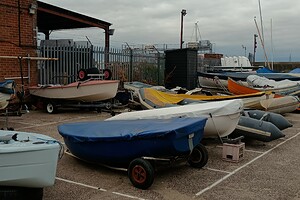Latest news
Time to Shift Your Boats!
Sadly another summer sailing season is reaching its end, and it is time to get moving. On the plus side we are planning our first 'Laying up Supper' in more than a while so watch out for a social events update. In the meantime - The West Compound cruiser 'lift-out' takes place on the 4/5th Nov 2025. Before this, as you may be aware we have the HYGA Harker's More »
11 Oct 2025
Micro Worlds 11th & 12th October
Next weekend it will be 2025 Micro-Worlds at the Club. On Saturday 11th - HW is 15:45, the Race Briefing is 12:45 and the First Start is 13:45. On Sunday 12th - HW is 16:30, the Race Briefing (if required) is 13:30 and the First Start is 14:30 The Notice of Race and the Sailing Instructions are included below. More »
5 Oct 2025
Micro Race 7/9/2025
Brilliant race today in slightly testing condition - quite windy!! Huge congrats to Andrew and Alex, our latest Micro owning team, who managed a very respectable third place and didn't get that wet, well during the race at least!! Maybe we need to keep an eye on them!! Looking forward to the Micro Worlds! More »
7 Sep 2025
2025 Lift-Out and Winter Storage
It is that time of year again! Lift out is scheduled for Tuesday 4th and Wednesday 5th November, the deadline for the applications for winter storage and/or lift out is September 21 st 2025. Limited storage is also available in the East Compound for craft under 16ft. The application forms can be found by clicking on the links below. No payment is required with the application. Members offered storage More »
31 Aug 2025
Upcoming events
| Dec 15 |
12:00 - Bar Lunchtime |
| Dec 16 |
12:00 - Bar Lunchtime |
| Dec 17 |
10:00 - Cake and CoffeeIn aid of St Helena Hospice |
| Dec 17 |
12:00 - Bar Lunchtime |
| Dec 17 |
18:00 - Bar-Evening |
Club location
Tide predictions for Mistley
|
Monday 15 December 2025 HW 08:08 3.51mHW 20:51 3.54m |
Tuesday 16 December 2025 HW 09:06 3.59mHW 21:43 3.65m |
Wednesday 17 December 2025 HW 10:00 3.69mHW 22:31 3.77m |
Thursday 18 December 2025 HW 10:49 3.78mHW 23:14 3.86m |
Friday 19 December 2025 HW 11:32 3.83mHW 23:52 3.91m |
Contains ADMIRALTY® data: © Crown copyright and database right










